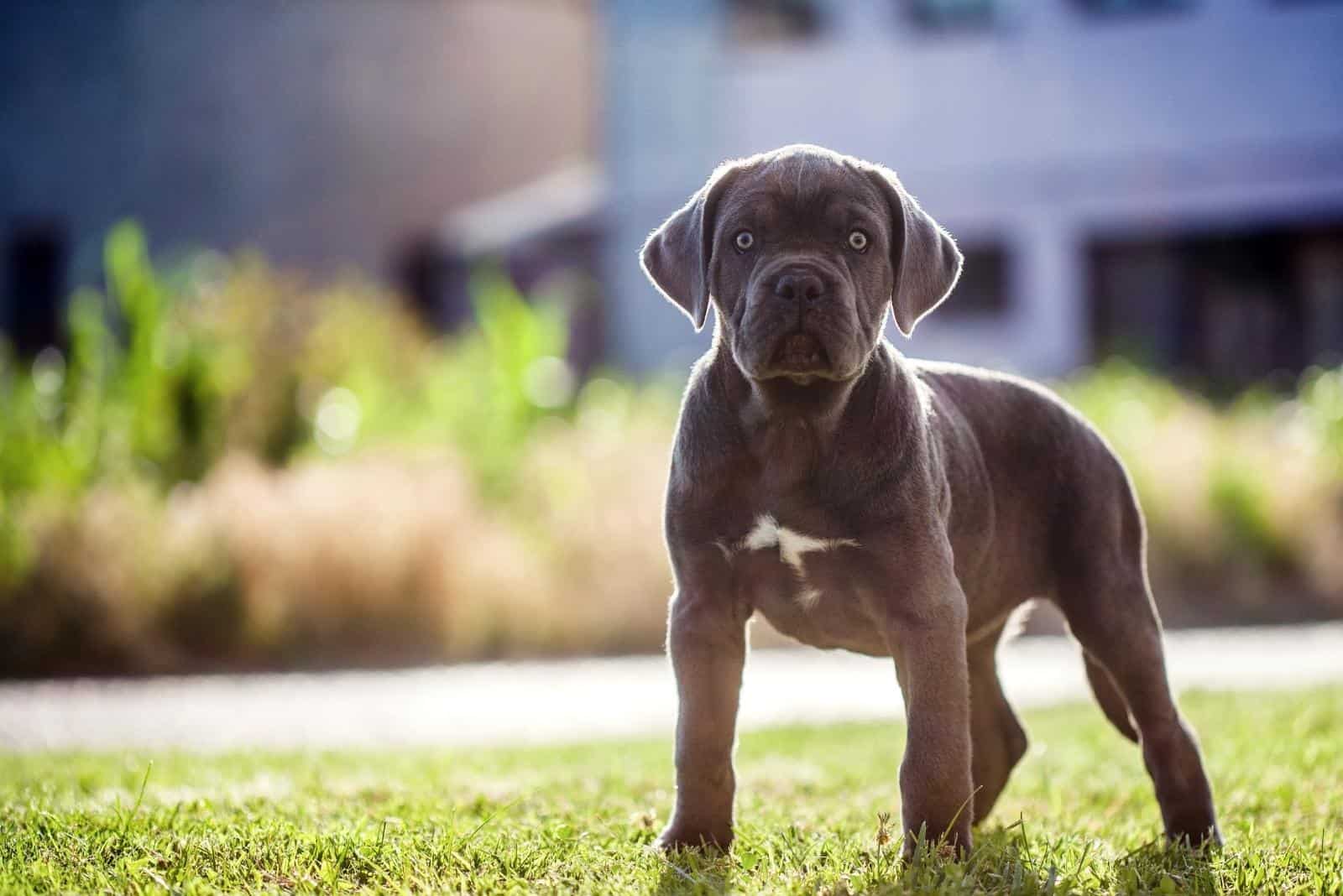The Cane Corso dog (also called the Italian Mastiff) is enormous. In fact, it’s listed as a giant breed.
A full-grown adult weighs between 90 and 120 pounds and is, ideally, proportionate to their height, usually between 25 and 27.5 inches at the withers (shoulders). For more details on this subject, check out this Cane Corso growth chart.
As you can imagine, dogs of this size will munch their way through a shed-load of food during their lifetime. But exactly how much do they eat? How often do you feed them? And what kind of food should you give them?
Find the answer to these questions and more in our Cane Corso feeding chart!
Cane Corso Puppy Feeding Chart
Although a dog is usually considered an adult at one year old, the puppy stage can last until 24 months of age. Large-breed puppies mature at around 15 months when their bones are fully developed, while sexual maturity usually happens earlier.
Social maturity is different depending on the breed – some dogs still act like puppies when they are 3 or 4 years old!.
During this time, your pup needs essential nutrients to give them the best chance of living a long and healthy life. Growing takes a lot of energy, and it’s your job to make sure their nutritional needs are met.
With this in mind, most experts recommend the following feeding plan, using good-quality kibble:
[table id=320 /]
Between the ages of six and twelve weeks, it’s a good idea to split the food into several small meals throughout the day (you can find more details as to why further down the page). Most Cane Corso owners feed their pups between four and six times a day, reducing this to three meals a day at six months of age.
It’s also advisable to introduce a small amount of wet food into their diet at around ten weeks. Speak to your vet and get some advice before doing so, as new foods can sometimes cause problems.
They can recommend a good brand of puppy food that you can try. You could also ask the breeder where you bought your pup, as they will be happy to advise you. They will have done a lot of research into the best Cane Corso foods, so why not take advantage of this?
When your pup reaches 10 to 12 months, you should feed them twice a day. They’ll also be able to move on to adult food at one year old, but once again, it’s always a good idea to check with your vet.
Cane Corso Puppy Raw Feeding Chart
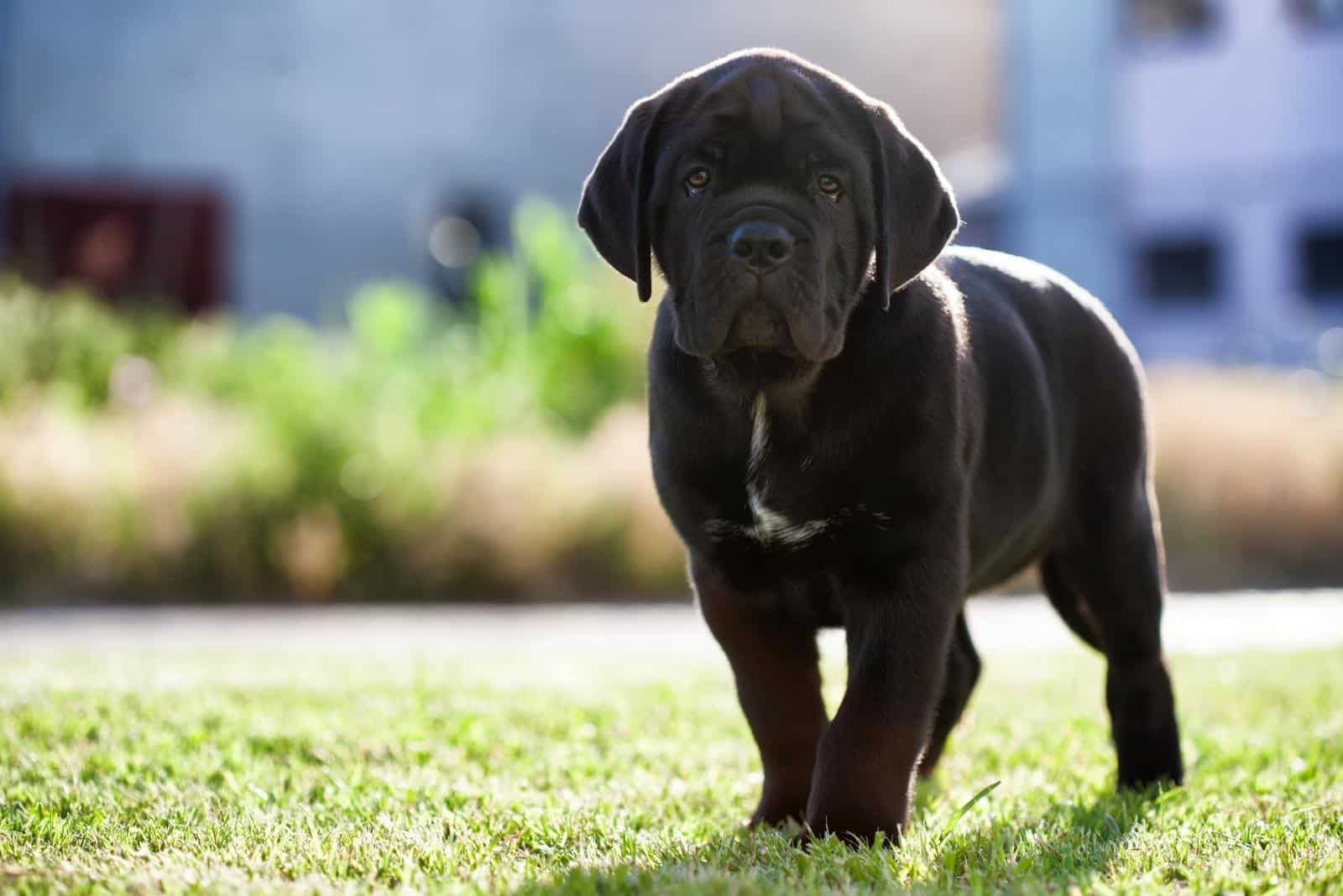
Many dog owners prefer to give their pups a raw food diet. It gives them more control and doesn’t contain preservatives or anything artificial.
You can find out more about the raw food diet below in the section called Can Cane Corso eat raw meat?
The main drawbacks of the raw food diet are the cost and the inconvenience. You can prepare it yourself, but this takes a lot of work. Alternatively, you can buy it ready-made, but this can be very expensive.
However, if you’re happy to go ahead and use this method, you might want some help, so here’s an example of a Cane Corso feeding chart for puppies eating a raw food diet:
[table id=321 /]
As you can see, it’s a lot more complicated than feeding your pup kibble and wet food!
While it’s undeniable that a raw food diet* offers a lot of benefits, few people get it right, putting their dog’s health at risk. You can read more about this in the section below about feeding your dog raw meat.
Commercial pet foods are sometimes considered less healthy than raw food. However, a good-quality brand (such as Purina, Nutro, Orijen, Royal Canin, or Hill’s) will ensure that your dog’s dietary needs are met.
*Sometimes called a BARF diet! BARF stands for either Biologically Appropriate Raw Food or Bones And Raw Food.
Cane Corso Raw Feeding Chart
Adult Cane Corsos eat more than puppies, and some of these dogs weigh as much as 120 pounds. They’re going to get through a lot of food during their lifetime!
If you opt for a raw food diet, this will be expensive, whether you prepare it yourself or buy a pre-made brand.
Here’s an idea for a Cane Corso feeding chart for adult dogs:
[table id=322 /]
How Many Times A Day Do Cane Corsos Eat?
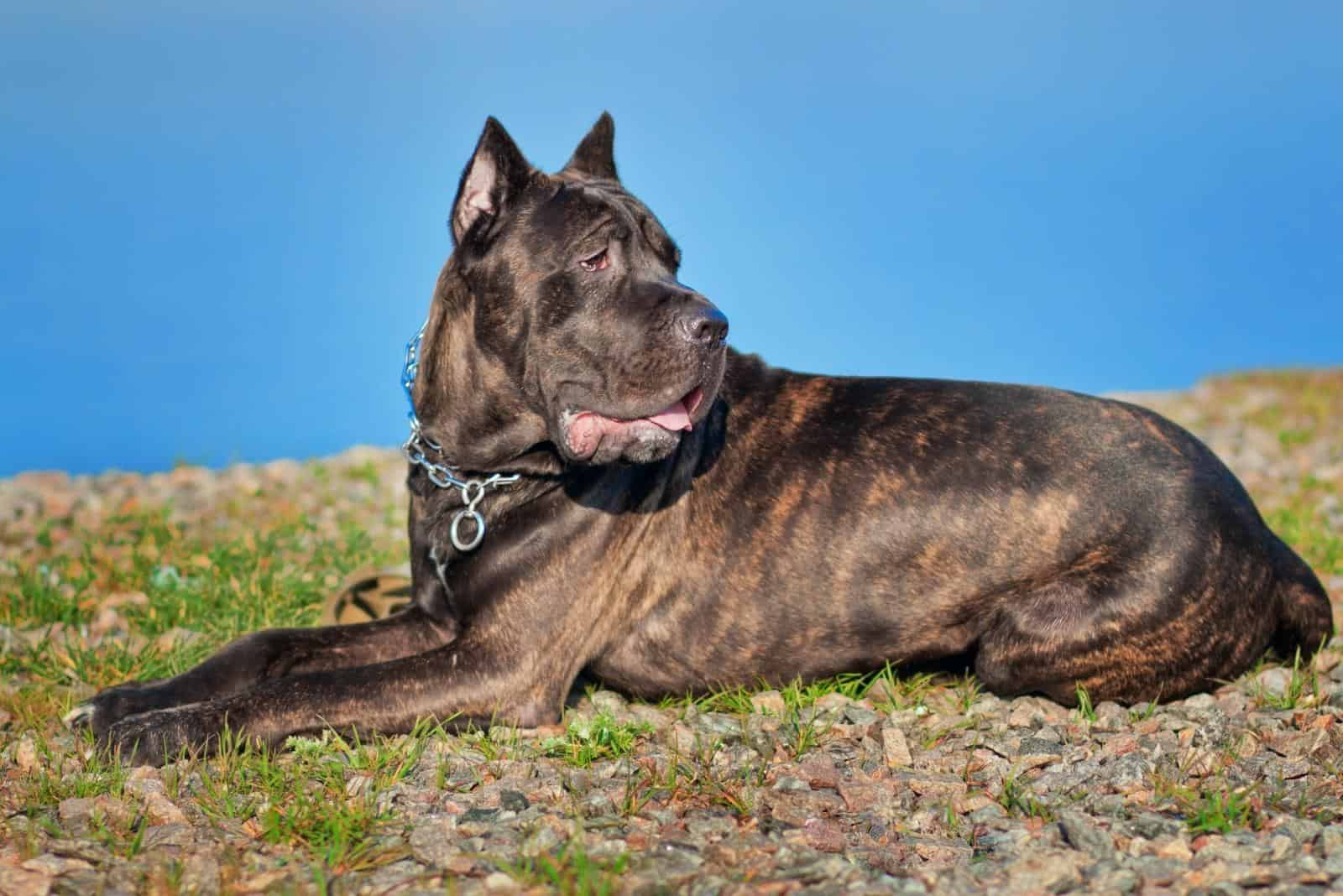
As you can see from the Cane Corso feeding chart, a Cane Corso puppy should be fed between three and six times a day, while for an adult, this should be reduced to two meals a day.
While you might not think that this is important, feeding your Cane Corso too much at once can have devastating consequences on its health.
When all dogs lived in the wild, they ate when they could, frequently going for days without a proper meal. Things are very different now, as the domesticated dog has come to rely on us and expects to be fed regularly.
Dogs are used to a schedule, which aids their digestion, helping their metabolism to manage their energy levels. It also keeps their bowel movements regular, which is good news for you as your dog (mostly) won’t need to disturb you at night to go to the bathroom!
Another good reason for limiting food to several smaller meals is that it reduces the risk of bloat. This condition mainly affects large breeds with deep chests, so the Cane Corso is a prime candidate.
Bloat is also called gastric dilatation-volvulus or gastric torsion. It usually occurs when a dog overeats or drinks excessively, directly before or after strenuous exercise. However, the exact cause is unknown, and stress has even been suggested as a possible factor.
When a dog suffers from bloat, its stomach inflates with gas or liquid, which is painful enough. The stomach then twists around on itself, taking the spleen and pancreas with it. This action traps gas inside and stops blood from reaching the vital organs, forcing it to pool in the dog’s hindquarters.
The pancreas adds to the problem as it can react strangely, producing a variety of toxic enzymes that flood the body and send it into shock, with a devastating effect on the heart. In some cases, these chemicals can stop a dog’s heart even after successful surgery.
Swift diagnosis and treatment are essential to your dog surviving this condition. Emergency surgery relieves the pressure and moves the stomach back into place. Dogs that undergo surgery have an 80–90% chance of surviving, but this drops significantly (to around 50%) if dead tissue has to be removed, usually from the stomach where it was deprived of blood.
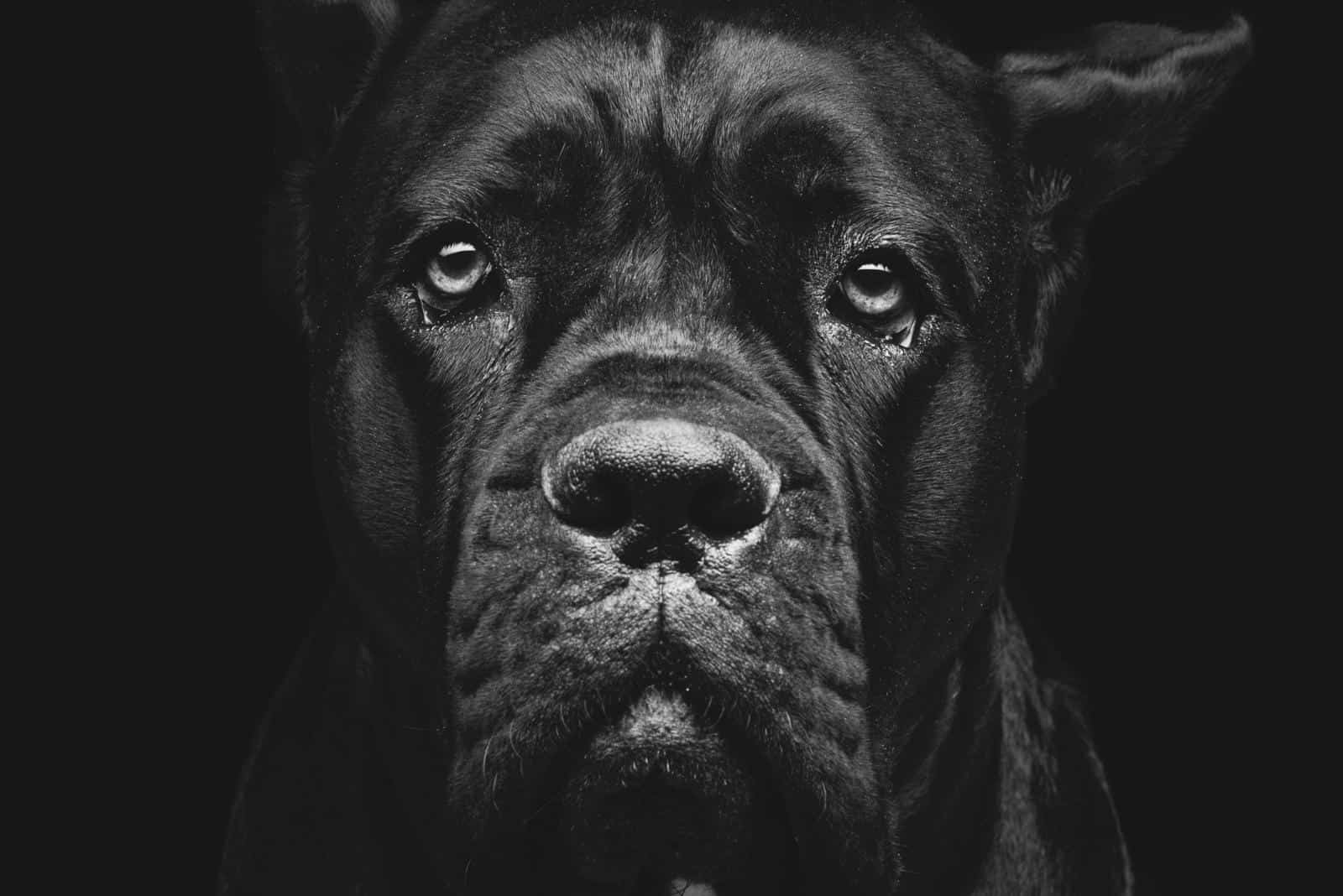
The Cane Corso is considered a high-risk breed for suffering from bloat, and the risk factor increases every year after three years of age.
It’s wise to be familiar with the symptoms of bloat so that you can get your dog the help it needs:
• General restlessness
• Salivating and drooling (as they can’t swallow)
• Pacing
• Gagging and retching but unable to vomit or belch
• A swollen belly that may be hard to the touch
• Whining, especially when the abdomen is touched
A dog with bloat may go into shock within two hours, so you must immediately get them to a vet.
One way to reduce the risk is to feed your dog smaller meals several times a day.
Some dog owners use the free-feeding approach, but this is not the best idea, particularly for large breed dogs.
With free-feeding, dry food is left out in a bowl all day, so the dog can nibble at it when it wants to. It might be convenient for you, but it won’t do your dog any favors. Bored dogs may be tempted to eat more, leading to obesity. Some dogs will eat the whole lot in a few minutes, and their owners often top up the bowl again, leading to overeating.
Also, dogs are happier with a regular schedule, with set meal times. A loss of appetite is usually the first sign of illness. If your dog always has food, it won’t be hungry when it comes to main meal times, so you won’t think anything of it if your puppy doesn’t eat.
The best approach is to set regular mealtimes with a measured amount of food.
How Much Food Does A Cane Corso Eat?
We’ve covered this in our Cane Corso feeding chart above, which is also linked to the issue of bloat we covered in the last section. However, it’s essential to go over the facts to clarify things.
The amount of food your dog will eat depends on its size, weight, age, and energy levels. What we can do is suggest an amount that they should be eating. Puppies eat much less than adult dogs, but they must get all the nutrients they need to develop properly.
Also, not all dog foods are the same when it comes to calorie content. One brand might have 400 calories per cup, while another might contain half as much.
Your choice of diet will also affect the amount of food your dog eats.
What Food Should I Feed My Cane Corso?
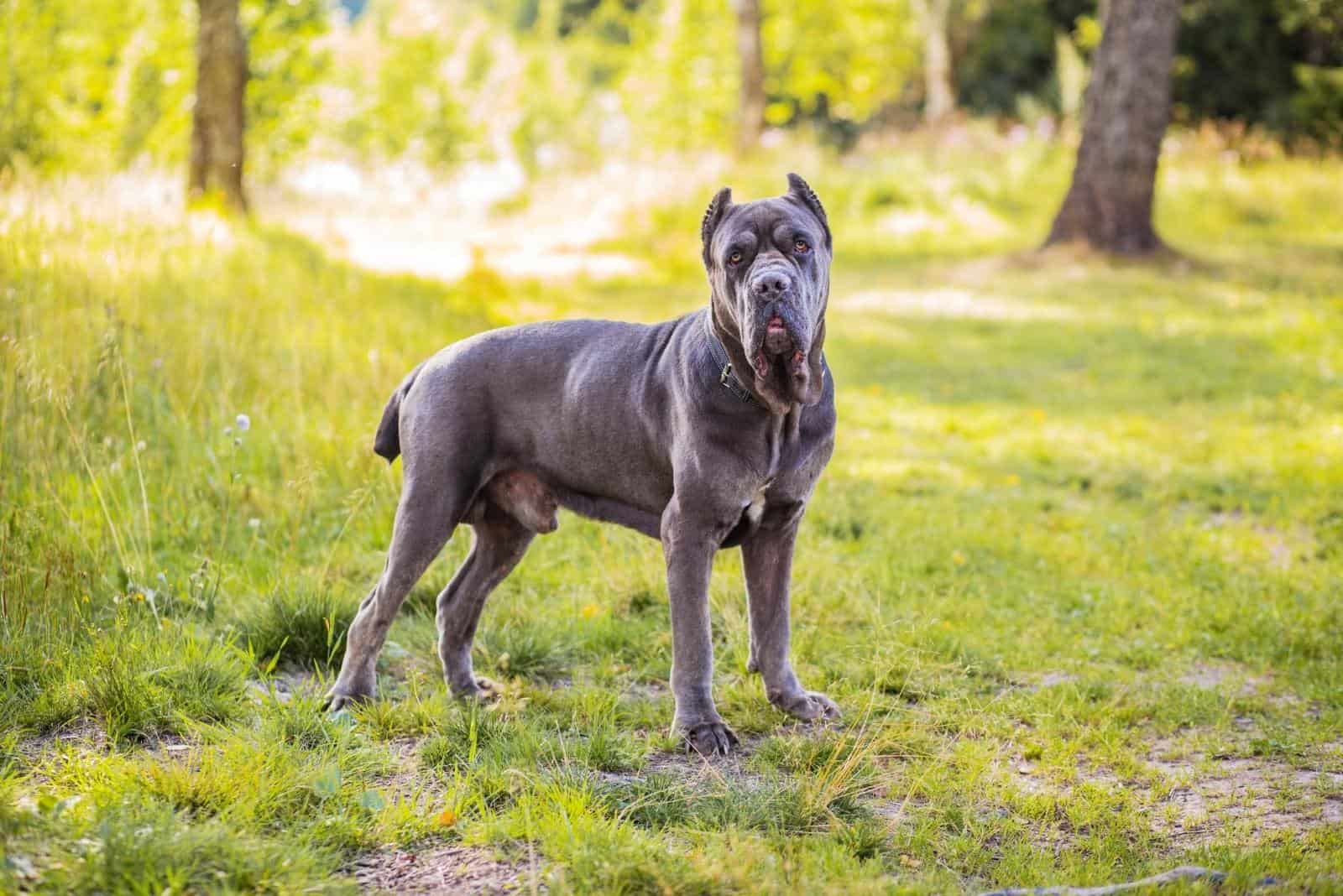
The Cane Corso requires a high-protein diet that doesn’t include too much fat and carbohydrates.
As with most large breed dogs, the Cane Corso can become obese if you’re not careful, increasing the risk of health problems. Being overweight can cause heart disease, cancer, diabetes, osteoarthritis, hypertension, and rapid joint degeneration.
So, what is the best dog food for them?
While you might choose one that’s good for your wallet, it’s always best to spend a little extra and buy premium quality food for the sake of your dog’s health.
A good quality dry kibble contains all the nutrients your pooch needs, without any fillers that cheap dog food usually has. Look for those that include glucosamine and chondroitin, as these will help form strong, healthy joints. Cane Corsos are prone to joint problems, such as hip dysplasia, and these ingredients will help.
Some dry dog food will also contain omega-3 (DHA) and omega-6 fatty acids, essential for healthy skin and coat.
If your pup has a sensitive tummy, look out for prebiotics and high fiber foods, as these will ease the problem.
Watch out for foods with too much calcium in them. While this is needed for strong bones, too much calcium can harm your dog’s joints. The same applies to phosphorus, and too many of these nutrients can lead to kidney disease and bladder stones.
The most important thing is to give your dog a balanced diet, with supplements if necessary.
Mixing dry and wet foods is a good way to add texture and flavor to your dog’s diet. The dry food gives a crunch and helps to keep your dog’s teeth clean, and wet foods add flavor and a different texture. Once again, this should be a top-quality food, as cheaper ones are packed with fillers that have zero nutritional value.
Always check any food to see what the first ingredient is. Ideally, it should be an animal protein, like lean chicken. Avoid anything that lists carbs as the first ingredient, as this will be bad for your dog!
Although grain is used as a filler in cheap foods, don’t opt for grain-free dog food. Dogs still need carbohydrates and fiber, which these provide, as well as protein and essential fatty acids.
An entirely grain-free diet will harm your dog. The only reason for cutting out grain is if your vet advises you to do so following a diagnosis of a food allergy. Even then, they will suggest replacements to make up for this.
Suppose your chosen food doesn’t include fruit and vegetables. In that case, you can supplement your dog’s diet by giving them apples, blueberries, strawberries, bananas, watermelon, peaches, etc., to provide the antioxidants they need.
These help fight free radicals, particles that can cause sicknesses, including cancer. Remove any pits/stones from the fruit, and don’t give them too many sugary fruits.
Never give dogs grapes, raisins, rhubarb, cherries, or avocado! Some will merely make your dog sick, while others (like grapes/raisins) can cause fatal kidney failure. You should also avoid giving your dog anything containing garlic, onions, or citrus fruits.
Most human foods are usually high in fat, salt, and additives that are harmful to dogs. Although the odd scrap of food here and there won’t hurt, it’s best to avoid it entirely and stick to healthy dog treats or a small piece of fruit.
Can Cane Corso Eat Raw Meat?
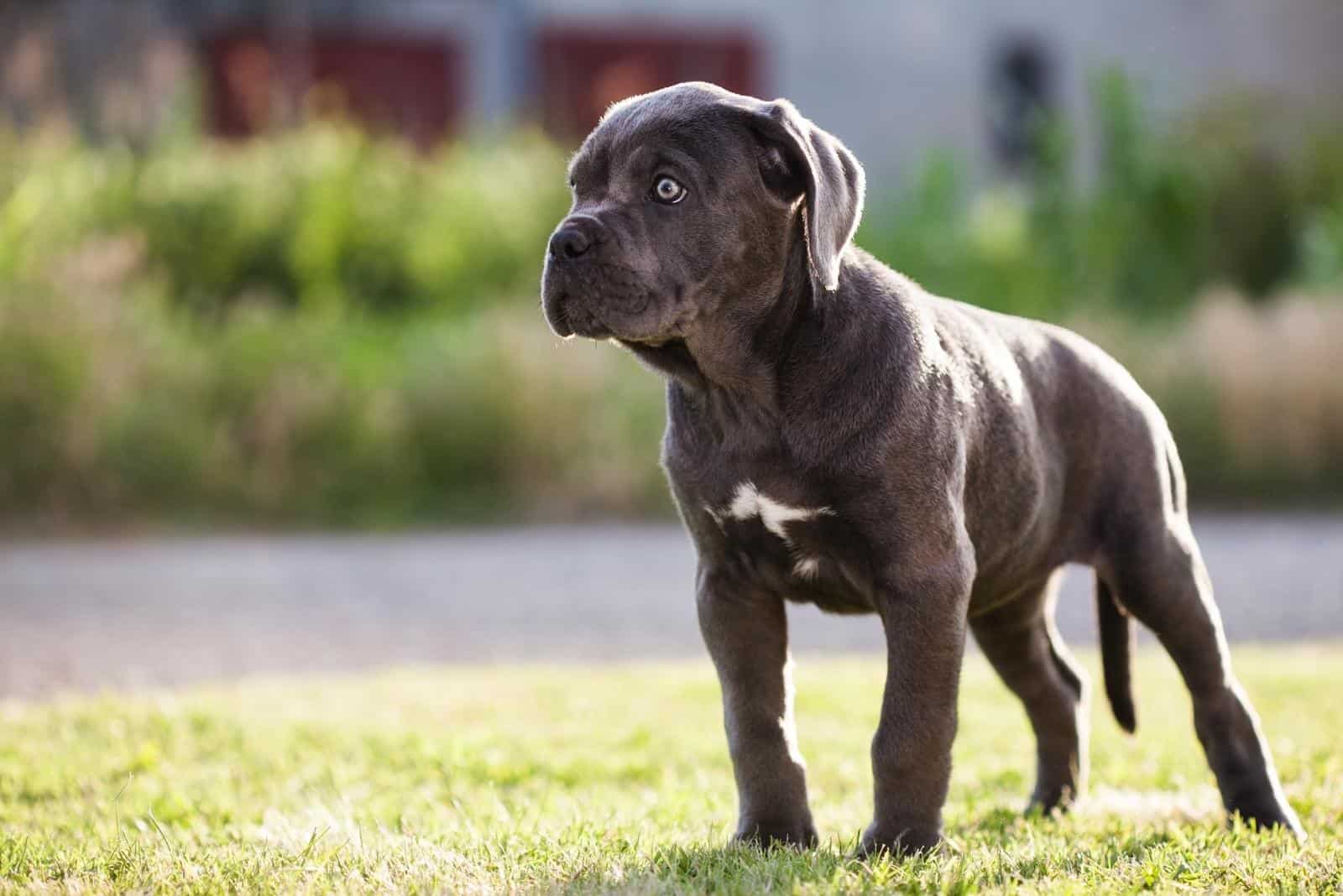
This is a controversial subject, with strong feelings on all sides. Those in the raw meat camp suggest that dogs are more carnivores than omnivores, which is a natural diet. They point out that, as dogs are descended from wolves, they share the same carnivorous nature.
They’ll also cite research highlighting that dogs have canine teeth and a lower intestine better suited to meat-eating. Ideally, this should be raw, as this is more natural.
Others agree that meat should form a large part of a dog’s diet, but they stipulate that you should always cook it first.
Meanwhile, in the veggie camp, people will draw attention to the many studies that prove beyond a doubt that dogs are, in fact, omnivores. Thousands of years of domestication have adapted their bodies to survive on a vegetarian diet. Recent studies suggest that dogs fed an entirely plant-based diet live longer than those fed a traditional meat-based diet.
Some people say that dogs should eat only raw veg as cooking them destroys goodness.
So, what’s the answer to our original question?
In short, Cane Corso can eat raw meat. However, it’s more a question of whether they should.
The science overwhelmingly shows that a diet consisting primarily of raw meat won’t provide all the required nutrition. This is especially so in developing puppies and senior dogs with a weaker immune system. Cooking meat also makes it easier to digest, aiding the absorption of nutrients that contribute to energy levels and building muscle.
The bottom line is that a raw food diet (formed chiefly of meat, with a few grains and vegetables) increases the risk of nutritional deficiencies and sickness, affecting the Cane Corso lifespan.
Fans of the raw food diet (RFD) like to compare pet dogs with their wild cousins who eat raw food most of the time, and they fail to mention that wild dogs have a shorter lifespan than domesticated dogs. The interesting thing about this fact is that studies prove that dogs fed on a diet primarily of raw meat share this fate.
Additionally, raw meat presents health risks to dogs and dog owners alike. There is a genuine risk of contamination from E. coli, listeria, and salmonella, among others. After eating the meat, your dog will deposit bacteria wherever it goes, mainly when it licks anything, including hands and faces.
There is also a chance that the dog will swallow small bones, which is a choking hazard and the risk of perforating the stomach lining or bowel.
The best advice is to stick to a balanced diet that provides all the nutrition your dog needs to live a long and healthy life. It must be handled with care and only used occasionally if you do include raw meat.
A raw diet is acceptable as part of an overall feeding program. By all means, use raw vegetables, like carrots, apples, and bananas, but this should only form 10% of the diet.
Final Thoughts
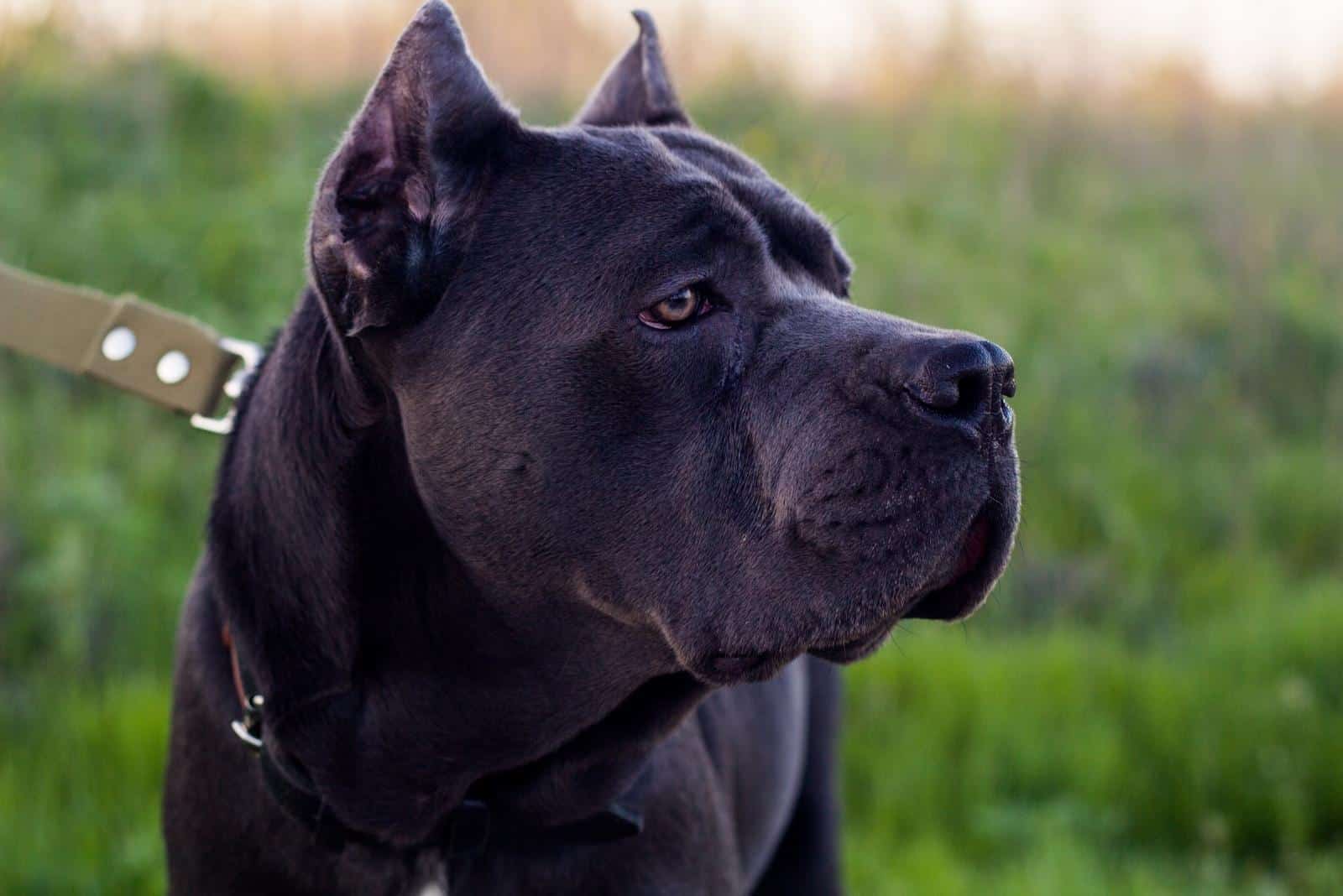
Along with a couple of Cane Corso feeding charts, we’ve tried to provide some helpful information to guide you.
As for the diet you choose for your dog, this is entirely your decision. The main thing is that it should be balanced and nutritious, providing your dog with the energy it needs to grow and remain healthy.
Ideally, you should select a brand with prebiotics and probiotics to help with your dog’s digestion. Don’t be put off by foods that contain brown rice, as this is healthy, as long as it makes up a small percentage of the ingredients.
An adult Cane Corso eats between 6 and 9 cups of food per day, which will be expensive. Dry food has the advantage of being (generally) cheaper, easier to store, and long-lasting. Wet food (in pouches or cans) is an excellent addition to your dog’s diet but must be used soon after opening.
A raw food diet is the most expensive and highly time-consuming if you prepare it yourself.
Whichever path you go down, always remember that your dog relies on you to give it the best chance of a healthy life.
A proper diet can also help you reduce your Cane Corso shedding amount to the minimum and ensure his skin and coat are healthy.
Read Next: Boerboel Feeding Chart: How Much Do These Dogs Eat?
